Review on the Synthesis, Recyclability, Degradability, Self-Healability and Potential Applications of Reversible Imine Bond Containing Biobased Epoxy Thermosets
Abstract
:1. Introduction
2. Imine-Based Adaptive Covalent Chemistry
3. Imine-Based Vitrimer Properties
4. Synthesis and Properties of Reprocessable Biobased Epoxy Thermosets Using Reversible Imine Bond
| Resources | Epoxy Resin | Curing Agent | Properties | Ref | ||
|---|---|---|---|---|---|---|
| Original | Reprocessed | Recycled | ||||
| Vanillin and Syringaldehyde | DGEBF | Vanillin Bisaminomethyl Cyclohexane | Tg = 92 °C σf = 106 MPa Ef = 2.37 GPa G = 3.08 GPa | Tg = 90 °C σf = 107 MPa Ef = 2.63 GPa G = 3.09 GPa | Tg = 84 °C σf = 111 MPa Ef = 2.61 GPa G = 3.14 GPa | [88] |
| Syringaldehyde Bisaminomethyl Cyclohexane | Tg = 82 °C σf = 107 MPa Ef = 2.35 GPa G = 2.82 GPa | Tg = 86 °C σf = 107 MPa Ef = 2.36 GPa G = 3.03 GPa | Tg = 85 °C σf = 112 MPa Ef = 2.37 GPa G = 2.84 GPa | |||
| Vanillin | Glycerol triglycidyl ether (Gte) | VA | Tg = 70 °C σ = 62 ± 7 MPa E = 1.6 ± 1.1 GPa ε = 7.2 ± 1.9% | Tg = 70 °C σ = 76 ± 1 MPa E = 2.0 ± 0.1 GPa ε = 8.9 ± 1.7% | σ = 63 ± 5 MPa E = 2.6 ± 1.1 GPa ε = 2.7 ± 0.1% | [92] |
| Vanillin | Vanillin-based epoxy resin (DADE) | D230 | Tg = 106 °C σ = 57.4 ± 3.6 MPa E = 2.52 ± 0.12 GPa ε = 3.1 ± 0.6% | Tg = 97 °C σ = 47 ± 4.4 MPa E = 2.53 ± 0.25 GPa ε = 2.2 ± 0.2% | [21] | |
| Vanillin | Hexa-vanillin terminated cyclophosphazene (HVP) | D230 | Tg = 98.4 °C σ = 58 MPa E = 1.84 GPa ε = 5.6% | σ = 56 MPa E = 1.77 GPa ε = 5.9% | [93] | |
| Vanillin | GE-VAN-AP | Jeffamine | Tg = 71 °C σ = 46 MPa ε = 4% G = 2.00 GPa | Tg = 72 °C σ = 41 MPa ε = 3.8% G = 2.11 GPa | [84] | |
| Vanillin | DGEBA | Van2HMDA | Tg = 88 °C σ = 85 MPa ε = 5.9% | Tg = 63 °C | [66] | |
| Vanillin | VAN-AC-EP | DDM | Tg = 146 °C σ = 44 ± 2.2 MPa E = 2.69 ± 0.11 GPa ε = 2.4 ± 0.09% G = 3.35 GPa | σ = 29 ± 1.3 MPa E = 2.98 ± 0.15 GPa ε = 1.1 ± 0.06% | [57] | |
| Vanillin | DGEBA | IH-VAN | Tg = 121 °C σ = 60.1 ± 1.5 MPa E = 2.57 ± 0.04 GPa G = 2.50 GPa | Tg = 127 °C σ = 53.6 ± 1.1 MPa E = 2.83 ± 0.04 GPa G = 2.66 GPa | Tg = 119 °C σ = 60.9 ± 1.0 MPa E = 2.61 ± 0.04 MPa G = 2.12 GPa | [86] |
| IH-HB | Tg = 127 °C σ = 60.6 ± 1.8 MPa E = 2.60 ± 0.04 GPa G = 2.94 GPa | Tg = 135 °C σ = 52.4 ± 0.9 MPa E= 2.86 ± 0.05 GPa G = 3.07 GPa | Tg = 124 °C σ = 58.3 ± 1.5 MPa E = 2.62 ± 0.03 GPa G = 2.63 GPa | |||
| Vanillin | AFG-90H | Vanillin and methylcyclohexane diamine | Tg = 131 °C σ = 82 MPa G = 2.96 GPa | σ = 79 MPa G = 3.80 GPa | [87] | |
| Vanillin | Glycerol diglycidyl ether (GDE) | HVPA | Tg = 118 °C σ = 38.8 ± 2.1 MPa E = 1.5 ± 0.16 GPa ε = 20.9 ± 1.90% | σ = 35.2 ± 2.1 MPa ε = 17.08 ± 1.90% | [94] | |
| Guaiacol and vanillin | Guaiacol–vanillin derivatives (GV-EP) | DDM | Tg = 220 °C E = 4.49 ± 0.06 GPa G = 3.60 GPa | Tg = 237 °C E = 5.60 ± 0.08 GPa G = 2.31 GPa | [95] | |
| Lignin | PBE, VBE | DDM | PBE-DDM Tg = 204 °C σ = 122 ± 9 MPa E = 2.65 ± 0.1 GPa ε = 8.7 ± 0.3% | [96] | ||
| VBE-DDM Tg = 196 °C σ = 93 ± 5 MPa E = 2.17 ± 0.09 GPa ε = 6.3 ± 0.2% | ||||||
| Vanillin | Dialdehyde Monomer from Vanillin (DAV) | Diethylenetriamine and tris(2-aminoethyl)amine | Tg = 60 °C σ = 51 ± 3.99 MPa E = 724 ± 43.7 MPa ε = 13.01 ± 1.51% | σ = 53 ± 2.27 MPa E = 526 ± 33.8 MPa ε = 18.29 ± 2.68% | [97] | |
| Vanillin | DGEBA | Van-OH | Tg = 96 °C σ = 79.1 MPa E = 2.47 GPa ε = 6.12% G = 2.65 GPa | σ = 48.8 MPa E = 2.46 GPa ε = 2.82% | [85] | |
| Soybean oil + Vanillin | Epoxidized soybean oil (ESO) | VA | Tg = 27.6 °C σ = 7.7 ± 1 MPa E = 41.4 ± 3.7 MPa ε = 144 ± 14% G = 4.98 MPa | σ = 7.6 ± 1 MPa E = 41.4 ± 3.7 MPa ε = 160 ± 14% | [98] | |
| Soybean oil + Vanillin | Epoxidized soybean oil (ESO) | VSB | Tg = 66 °C σ = 37.4 ± 4.1 MPa E = 1.02 ± 0.04 GPa ε = 6 ± 1% | σ = 37.4 ± 4.1 MPa E = 1.02 ± 0.04 GPa ε = 6 ± 1% | [24] | |
| Vanillin | Mono-glycidyl structure of vanillin (Van-Ep) | Isophorone diamine (IPDA) | Tg = 121 °C σ = 65 ± 5.2 MPa E = 2.30 ± 0.23 GPa ε = 4.4 ± 0.7% G = 3.56 GPa | σ = 65.7 ± 2.8 MPa E = 2.61 ± 0.16 GPa ε= 3.7 ± 0.4% | [99] | |
| Vanillin | MB | PACM | Tg = 172 °C σ = 81 ± 1.2 MPa E = 2.11 ± 0.05 GPa ε = 15 ± 0.8% | Tg = 175 °C σ = 81 ± 1.8 MPa E = 2.28 ± 0.03 GPa ε = 13 ± 0.4% | [45] | |
| Vanillin | GTE | VPDA | Tg = 107 °C σ = 93 ± 14.4 MPa E = 1.41 ± 0.21 GPa ε = 12.3 ± 3.6% G = 2.51 GPa | Tg = 107 °C σ = 95 ± 14.4 MPa E = 1.51 ±49 GPa ε = 8 ± 0.8% | σ = 98 ± 14.4 MPa E = 1.51 ±49 GPa ε = 7 ± 0.8% | [100] |
5. Reprocessability and Recyclability of Bio-Based Epoxy Thermosets Based on Reversible Imine Bond
6. Degradation of Bio-Based Epoxy Thermosets Based on Dynamic Imine Bond
7. Self-Healability of Biobased Epoxy Thermosets Based on Imine Bond
8. Potential Application of Epoxy Resin
8.1. Coating
8.2. Adhesives
8.3. Electronics
8.4. Biomedical
8.5. Environmentally Friendly Polymer Matrix for Fibre-Reinforced Composite
9. Challenges and Future Prospects
10. Conclusions
Funding
Acknowledgments
Conflicts of Interest
References
- Xu, Y.; Odelius, K.; Hakkarainen, M. Photocurable, Thermally Reprocessable, and Chemically Recyclable Vanillin-Based Imine Thermosets. ACS Sustain. Chem. Eng. 2020, 8, 17272–17279. [Google Scholar] [CrossRef]
- Liguori, A.; Hakkarainen, M. Designed from Biobased Materials for Recycling: Imine-Based Covalent Adaptable Networks. Macromol. Rapid Commun. 2022, 43, e2100816. [Google Scholar] [CrossRef]
- Rashid, M.A.; Liu, W.; Wei, Y.; Jiang, Q. Review of intrinsically recyclable biobased epoxy thermosets enabled by dynamic chemical bonds. Polym.-Plast. Technol. Mater. 2022, 61, 1740–1782. [Google Scholar] [CrossRef]
- Aiswarya, S.; Awasthi, P.; Banerjee, S.S. Self-healing thermoplastic elastomeric materials: Challenges, opportunities and new approaches. Eur. Polym. J. 2022, 181, 111658. [Google Scholar] [CrossRef]
- Zhao, X.-L.; Li, Y.-D.; Zeng, J.-B. Progress in the design and synthesis of biobased epoxy covalent adaptable networks. Polym. Chem. 2022, 13, 6573–6588. [Google Scholar] [CrossRef]
- Ma, S.; Webster, D.C. Degradable thermosets based on labile bonds or linkages: A review. Prog. Polym. Sci. 2018, 76, 65–110. [Google Scholar] [CrossRef]
- Memon, H.; Wei, Y.; Zhu, C. Recyclable and reformable epoxy resins based on dynamic covalent bonds–Present, past, and future. Polym. Test. 2022, 105, 107420. [Google Scholar] [CrossRef]
- Ding, C.; Matharu, A.S. Recent Developments on Biobased Curing Agents: A Review of Their Preparation and Use. ACS Sustain. Chem. Eng. 2014, 2, 2217–2236. [Google Scholar] [CrossRef]
- Rashid, M.A.; Liu, W.; Wei, Y.; Jiang, Q. Review of reversible dynamic bonds containing intrinsically flame retardant biomass thermosets. Eur. Polym. J. 2022, 173, 111263. [Google Scholar] [CrossRef]
- Auvergne, R.; Caillol, S.; David, G.; Boutevin, B.; Pascault, J.-P. Biobased thermosetting epoxy: Present and future. Chem. Rev. 2014, 114, 1082–1115. [Google Scholar] [CrossRef]
- Jian, X.-Y.; He, Y.; Li, Y.-D.; Wang, M.; Zeng, J.-B. Curing of epoxidized soybean oil with crystalline oligomeric poly(butylene succinate) towards high performance and sustainable epoxy resins. Chem. Eng. J. 2017, 326, 875–885. [Google Scholar] [CrossRef]
- Zhao, S.; Huang, X.; Whelton, A.J.; Abu-omar, M.M. Renewable Epoxy Thermosets from Fully Lignin-Derived Triphenols. ACS Sustain. Chem. Eng. 2018, 6, 7600–7608. [Google Scholar] [CrossRef]
- Huang, B.; He, H.; Dufresne, A.; He, X.; Wang, S. Enhancing toughness, healing and reprocessability of sustainable epoxy vitrimer composites by PEG-assisted regenerated cellulose. Ind. Crops Prod. 2021, 170, 113804. [Google Scholar] [CrossRef]
- Zhao, W.; Feng, Z.; Liang, Z.; Lv, Y.; Xiang, F.; Xiong, C.; Duan, C.; Dai, L.; Ni, Y. Vitrimer-Cellulose Paper Composites: A New Class of Strong, Smart, Green, and Sustainable Materials. ACS Appl. Mater. Interfaces 2019, 11, 36090–36099. [Google Scholar] [CrossRef]
- Qin, X.; Ge, W.; Mei, H.; Li, L.; Zheng, S. Toughness improvement of epoxy thermosets with cellulose nanocrystals. Polym. Int. 2021, 70, 1640–1648. [Google Scholar] [CrossRef]
- Xue, B.; Tang, R.; Xue, D.; Guan, Y.; Sun, Y.; Zhao, W.; Tan, J.; Li, X. Sustainable alternative for bisphenol A epoxy resin high-performance and recyclable lignin-based epoxy vitrimers. Ind. Crops Prod. 2021, 168, 113583. [Google Scholar] [CrossRef]
- Tang, R.; Xue, B.; Tan, J.; Guan, Y.; Wen, J.; Li, X.; Zhao, W. Regulating lignin-based epoxy vitrimer performance by fine-tuning the lignin structure. ACS Appl. Polym. Mater. 2022, 4, 1117–1125. [Google Scholar] [CrossRef]
- Moreno, A.; Morsali, M.; Sipponen, M.H. Catalyst-free synthesis of lignin vitrimers with tunable mechanical properties: Circular polymers and recoverable adhesives. ACS Appl. Mater. Interfaces 2021, 13, 57952–57961. [Google Scholar] [CrossRef]
- Rashid, M.A.; Hasan, M.N.; Dayan, M.A.R.; Jamal, M.S.I.; Patoary, M.K. A Critical Review of Sustainable Vanillin-modified Vitrimers: Synthesis, Challenge and Prospects. Reactions 2023, 4, 66–91. [Google Scholar] [CrossRef]
- Rashid, M.A.; Mian, M.M.; Wei, Y.; Liu, W. A vanillin-derived hardener for recyclable, degradable and self-healable high-performance epoxy vitrimers based on transimination. Mater. Today Commun. 2023, 35, 106178. [Google Scholar] [CrossRef]
- Su, X.; Zhou, Z.; Liu, J.; Luo, J.; Liu, R. A recyclable vanillin-based epoxy resin with high-performance that can compete with DGEBA. Eur. Polym. J. 2020, 140, 110053. [Google Scholar] [CrossRef]
- Fei, M.; Liu, T.; Zhao, B.; Otero, A.; Chang, Y.-C.; Zhang, J. From Glassy Plastic to Ductile Elastomer: Vegetable Oil-Based UV-Curable Vitrimers and Their Potential Use in 3D Printing. ACS Appl. Polym. Mater. 2021, 3, 2470–2479. [Google Scholar] [CrossRef]
- Liu, Y.-Y.; He, J.; Li, Y.-D.; Zhao, X.-L.; Zheng, J.-B. Biobased, reprocessable and weldable epoxy vitrimers from epoxidized soybean oil. Ind. Crops Prod. 2020, 153, 112576. [Google Scholar] [CrossRef]
- Zhao, X.-L.; Liu, Y.-Y.; Weng, Y.; Li, Y.-D.; Zheng, J.-B. Sustainable Epoxy Vitrimers from Epoxidized Soybean Oil and Vanillin. ACS Sustain. Chem. Eng. 2020, 8, 15020–15029. [Google Scholar] [CrossRef]
- Dhers, S.; Vantomme, G.; Avérous, L. A fully bio-based polyimine vitrimer derived from fructose. Green. Chem. 2019, 21, 1596–1601. [Google Scholar] [CrossRef]
- Nabipour, H.; Wang, X.; Song, L.; Hu, Y. A furan-derived epoxy thermoset with inherent anti-flammability, degradability, and raw material recycling. Mater. Today Chem. 2023, 27, 101315. [Google Scholar] [CrossRef]
- Jiang, Y.; Yun, J.; Pan, X. Renewable Furan-Based Epoxy Resins Derived from 5-Hydroxymethylfurfural and Furfural. ACS Sustain. Chem. Eng. 2022, 10, 16555–16562. [Google Scholar] [CrossRef]
- Trejo-Machin, A.; Puchot, L.; Verge, P. A cardanol-based polybenzoxazine vitrimer: Recycling, reshaping and reversible adhesion. Polym. Chem. 2020, 11, 7026–7034. [Google Scholar] [CrossRef]
- Liu, G.; Jin, C.; Huo, S.; Kong, Z.; Chu, F. Preparation and properties of novel bio-based epoxy resin thermosets from lignin oligomers and cardanol. Int. J. Biol. Macromol. 2021, 193, 1400–1408. [Google Scholar] [CrossRef]
- Hu, Y.; Tong, S.; Sha, Y.; Yu, J.; Hu, L.; Huang, Q.; Jia, P.; Zhou, Y. Cardanol-based epoxy vitrimer/carbon fiber composites with integrated mechanical, self-healing, reprocessable, and welding properties and degradability. Chem. Eng. J. 2023, 471, 144633. [Google Scholar] [CrossRef]
- Zeng, Y.; Li, J.; Liu, S.; Yang, B. Rosin-Based Epoxy Vitrimers with Dynamic Boronic Ester Bonds. Polymers 2021, 13, 3386. [Google Scholar] [CrossRef]
- Zhang, H.; Li, W.; Xu, J.; Shang, S.; Song, Z. Synthesis and characterization of bio-based epoxy thermosets using rosin-based epoxy monomer. Iran. Polym. J. 2021, 30, 643–654. [Google Scholar] [CrossRef]
- Zeng, Y.; Yang, B.; Luo, Z.; Pan, X.; Ning, Z. Fully rosin-based epoxy vitrimers with high mechanical and thermostability properties, thermo-healing and closed-loop recycling. Eur. Polym. J. 2022, 181, 111643. [Google Scholar] [CrossRef]
- Huang, J.; Zhang, J.; Zhu, G.; Yu, X.; Hu, Y.; Shang, Q.; Chen, J.; Hu, L.; Zhou, Y. Self-healing, high-performance, and high-biobased-content UV-curable coatings derived from rubber seed oil and itaconic acid. Prog. Org. Coat. 2021, 159, 106391. [Google Scholar] [CrossRef]
- Liu, Y.; Wang, B.; Ma, S.; Xu, X.; Qiu, J.; Li, Q.; Wang, S.; Lu, N.; Ye, J.; Zhu, J. Phosphate-based covalent adaptable networks with recyclability and flame retardancy from bioresources. Eur. Polym. J. 2021, 144, 110236. [Google Scholar] [CrossRef]
- Zhang, J.; Gong, Z.; Wu, C.; Li, T.; Tang, Y.; Wu, J.; Jiang, C.; Miao, M.; Zhang, D. Itaconic acid-based hyperbranched polymer toughened epoxy resins with rapid stress relaxation, superb solvent resistance and closed-loop recyclability. Green. Chem. 2022, 24, 6900–6911. [Google Scholar] [CrossRef]
- Rashid, M.A.; Zhu, S.; Zhang, L.; Wei, Y.; Liu, W. A Quercetin-Derived Polybasic Acid Hardener for Reprocessable and Degradable Epoxy Resins Based on Transesterification. ACS Appl. Polym. Mater. 2022, 4, 5708–5716. [Google Scholar] [CrossRef]
- Kristufek, S.L.; Yang, S.; Link, L.A.; Rohde, B.J.; Robertson, M.L.; Wooley, K.L. Synthesis, Characterization, and Cross-Linking Strategy of a Quercetin-Based Epoxidized Monomer as a Naturally-Derived Replacement for BPA in Epoxy Resins. ChemSusChem 2016, 9, 2135–2142. [Google Scholar] [CrossRef]
- Baroncini, E.A.; Yadav, S.K.; Palmese, G.R.; Stanzione, J.F. Recent advances in bio-based epoxy resins and bio-based epoxy curing agents. J. Appl. Polym. Sci. 2016, 133, 44103. [Google Scholar] [CrossRef]
- Kumar, S.; Samal, S.K.; Mohanty, S.; Nayak, S.K. Recent Development of Biobased Epoxy Resins: A Review. Polym.-Plast. Technol. Eng. 2018, 57, 133–155. [Google Scholar] [CrossRef]
- Rashid, M.A.; Liu, W.; Wei, Y.; Jiang, Q. Review on intrinsically recyclable flame retardant thermosets enabled through covalent bonds. J. Appl. Polym. Sci. 2022, 139, e52493. [Google Scholar] [CrossRef]
- Chen, X.; Dam, M.A.; Ono, K.; Mal, A.; Shen, H.; Nutt, S.R.; Sheran, K.; Wudl, F. A Thermally Re-mendable Cross-Linked Polymeric Material. Science 2002, 295, 1698–1702. [Google Scholar] [CrossRef]
- Kloxin, C.J.; Scott, T.F.; Adzima, B.J.; Bowman, C.N. Covalent Adaptable Networks (CANs): A Unique Paradigm in Cross-Linked Polymers. Macromolecules 2010, 43, 2643–2653. [Google Scholar] [CrossRef]
- Wang, B.; Ma, M.; Yan, S.; Zhu, J. Readily recyclable carbon fiber reinforced composites based on degradable thermosets: A review. Green. Chem. 2019, 21, 5781–5796. [Google Scholar] [CrossRef]
- Wang, S.; Ma, S.; Li, Q.; Xu, X.; Wang, B.; Yuan, W.; Zhou, S.; You, S.; Zhu, J. Facile in situ preparation of high-performance epoxy vitrimer from renewable resources and its application in nondestructive recyclable carbon fiber composite. Green. Chem. 2019, 21, 1484–1497. [Google Scholar] [CrossRef]
- Yu, K.; Shi, Q.; Dunn, M.L.; Wang, T.; Qi, H.J. Carbon Fiber Reinforced Thermoset Composite with Near 100% Recyclability. Adv. Funct. Mater. 2016, 26, 6098–6106. [Google Scholar] [CrossRef]
- Yuan, Y.; Sun, Y.; Yan, S.; Zhao, J.; Liu, S.; Zhang, M.; Zheng, X.; Jia, L. Multiply fully recyclable carbon fibre reinforced heat-resistant covalent thermosetting advanced composites. Nat. Commun. 2017, 8, 14657. [Google Scholar] [CrossRef]
- Tratnik, N.; Tanguy, N.R.; Yan, N. Recyclable, self-strengthening starch-based epoxy vitrimer facilitated by exchangeable disulfide bonds. Chem. Eng. J. 2023, 451, 138610. [Google Scholar] [CrossRef]
- Zhou, F.; Guo, Z.; Wang, W.; Lei, X.; Zhang, B.; Zhang, H.; Zhang, Q. Preparation of self-healing, recyclable epoxy resins and low-electrical resistance composites based on double-disulfide bond exchange. Compos. Sci. Technol. 2018, 167, 79–85. [Google Scholar] [CrossRef]
- Li, X.; Zhang, J.; Zhang, L.; Luzuriaga, A.R.D.; Rekondo, A.; Wang, D.Y. Recyclable flame-retardant epoxy composites based on disulfide bonds: Flammability and recyclability. Compos. Commun. 2021, 25, 100754. [Google Scholar] [CrossRef]
- Zeng, Y.; Liu, S.; Xu, X.; Chen, Y.; Zhang, F. Fabrication and curing properties of o-cresol formaldehyde epoxy resin with reversible cross-links by dynamic boronic ester bonds. Polymer 2020, 211, 123116. [Google Scholar] [CrossRef]
- Zhao, W.; An, L.; Wang, S. Recyclable High-Performance Epoxy-Anhydride Resins with DMP-30 as the Catalyst of Transesterification Reactions. Polymers 2021, 13, 296. [Google Scholar] [CrossRef]
- Chen, J.-H.; Lu, J.H.; Pu, X.L.; Chen, L.; Wang, Y.Z. Recyclable, malleable and intrinsically flame-retardant epoxy resin with catalytic transesterification. Chemosphere 2022, 294, 133778. [Google Scholar] [CrossRef]
- Toendepi, I.; Zhu, S.; Liu, Y.; Zhang, L.; Wei, Y.; Liu, W. Synthesis and structure-property relationship of epoxy vitrimers containing different acetal structures. Polymer 2023, 272, 125862. [Google Scholar] [CrossRef]
- Chen, J.; Zhang, K.; Zhang, K.; Jiang, B.; Huang, Y. Facile preparation of reprocessable and degradable phenolic resin based on dynamic acetal motifs. Polym. Degrad. Stab. 2022, 196, 109818. [Google Scholar] [CrossRef]
- Kuroyanagi, M.; Yamaguchi, A.; Hashimoto, T.; Urushisaki, M.; Sakaguchi, T.; Kawabe, K. Novel degradable acetal-linkage-containing epoxy resins with high thermal stability: Synthesis and application in carbon fiber-reinforced plastics. Polym. J. 2022, 54, 313–322. [Google Scholar] [CrossRef]
- Jiang, Y.; Wang, S.; Dong, W.; Kaneko, T.; Chen, M.; Shi, D. High-Strength, Degradable and Recyclable Epoxy Resin Based on Imine Bonds for Its Carbon-Fiber-Reinforced Composites. Materials 2023, 16, 1604. [Google Scholar] [CrossRef]
- Qin, J.; Liu, X.; Chen, B.; Liu, J.; Wu, M.; Tan, L.; Yang, C.; Liang, L. Thermo-healing and recyclable epoxy thermosets based on dynamic phenol-carbamate bonds. React. Funct. Polym. 2022, 180, 105411. [Google Scholar] [CrossRef]
- Fortman, D.J.; Sheppard, D.T.; Dichtel, W.R. Reprocessing Cross-Linked Polyurethanes by Catalyzing Carbamate Exchange. Macromolecules 2019, 52, 6330–6335. [Google Scholar] [CrossRef]
- Lorero, I.; Rodriguez, A.; Campo, M.; Prolongo, S.G. Thermally remendable, weldable, and recyclable epoxy network crosslinked with reversible Diels-alder bonds. Polymer 2022, 259, 125334. [Google Scholar] [CrossRef]
- Puyadena, M.; Calafel, I.; Roman, E.G.D.S.; Martin, L.; Gonzalez, A.; Irusta, L. Recyclable Epoxy Resin via Simultaneous Dual Permanent/Reversible Crosslinking Based on Diels–Alder Chemistry. Macromol. Chem. Phys. 2021, 222, 2100146. [Google Scholar] [CrossRef]
- Nishimura, Y.; Chung, J.; Muradyan, H.; Guan, Z. Silyl Ether as a Robust and Thermally Stable Dynamic Covalent Motif for Malleable Polymer Design. J. Am. Chem. Soc. 2017, 139, 14881–14884. [Google Scholar] [CrossRef] [PubMed]
- Liu, Q.; Jiang, L.; Zhao, Y.; Wang, Y.; Lei, J. Reprocessable and Shape Memory Thermosetting Epoxy Resins Based on Silyl Ether Equilibration. Macromol. Chem. Phys. 2019, 220, 1900149. [Google Scholar] [CrossRef]
- Shi, Q.; Yu, K.; Dunn, M.L.; Wang, T.; Qi, H.J. Solvent Assisted Pressure-Free Surface Welding and Reprocessing of Malleable Epoxy Polymers. Macromolecules 2016, 49, 5527–5537. [Google Scholar] [CrossRef]
- Xu, W.M.; Rong, M.Z.; Zhang, M.Q. Sunlight driven self-healing, reshaping and recycling of a robust, transparent and yellowing-resistant polymer. J. Mater. Chem. A 2016, 4, 10683–10690. [Google Scholar] [CrossRef]
- Mai, V.D.; Shin, S.R.; Lee, D.S.; Kang, I. Thermal Healing, Reshaping and Ecofriendly Recycling of Epoxy Resin Crosslinked with Schiff Base of Vanillin and Hexane-1,6-Diamine. Polymers 2019, 11, 293. [Google Scholar] [CrossRef] [PubMed]
- Bowman, C.N.; Kloxin, C.J. Covalent adaptable networks: Reversible bond structures incorporated in polymer networks. Angew. Chem. Int. Ed. Engl. 2012, 51, 4272–4274. [Google Scholar] [CrossRef]
- Denissen, W.; Winne, J.M.; Prez, F.E.D. Vitrimers: Permanent organic networks with glass-like fluidity. Chem. Sci. 2016, 7, 30–38. [Google Scholar] [CrossRef]
- Van Zee, N.J.; Nicolaÿ, R. Vitrimers: Permanently crosslinked polymers with dynamic network topology. Prog. Polym. Sci. 2020, 104, 101233. [Google Scholar] [CrossRef]
- Gandini, A. The furan/maleimide Diels–Alder reaction: A versatile click–unclick tool in macromolecular synthesis. Prog. Polym. Sci. 2013, 38, 1–29. [Google Scholar] [CrossRef]
- Kaur, G.; Johnston, P.; Saito, K. Photo-reversible dimerisation reactions and their applications in polymeric systems. Polym. Chem. 2014, 5, 2171–2186. [Google Scholar] [CrossRef]
- Huang, S.; Kong, X.; Xiong, Y.; Zhang, X.; Chen, H.; Jiang, W.; Niu, Y.; Xu, W.; Ren, C. An overview of dynamic covalent bonds in polymer material and their applications. Eur. Polym. J. 2020, 141, 110094. [Google Scholar] [CrossRef]
- Ciaccia, M.; Di Stefano, S. Mechanisms of imine exchange reactions in organic solvents. Org. Biomol. Chem. 2015, 13, 646–654. [Google Scholar] [CrossRef] [PubMed]
- Ciaccia, M.; Cacciapaglia, R.; Mencarelli, P.; Mandolini, L.; Stefano, S.D. Fast transimination in organic solvents in the absence of proton and metal catalysts. A key to imine metathesis catalyzed by primary amines under mild conditions. Chem. Sci. 2013, 4, 2253–2261. [Google Scholar] [CrossRef]
- Nabipour, H.; Wang, X.; Song, L.; Hu, Y. A high performance fully bio-based epoxy thermoset from a syringaldehyde-derived epoxy monomer cured by furan-derived amine. Green. Chem. 2021, 23, 501–510. [Google Scholar] [CrossRef]
- Wilhelms, N.; Kulchat, S.; Lehn, J.M. Organocatalysis of CN/CN and CC/CN Exchange in Dynamic Covalent Chemistry. Helv. Chim. Acta 2012, 95, 2635–2651. [Google Scholar] [CrossRef]
- Belowich, M.E.; Stoddart, J.F. Dynamic imine chemistry. Chem. Soc. Rev. 2012, 41, 2003–2024. [Google Scholar] [CrossRef]
- Chao, A.; Negulescu, I.; Zhang, D. Dynamic Covalent Polymer Networks Based on Degenerative Imine Bond Exchange: Tuning the Malleability and Self-Healing Properties by Solvent. Macromolecules 2016, 49, 6277–6284. [Google Scholar] [CrossRef]
- Godoy-Alcántar, C.; Yatsimirsky, A.K.; Lehn, J.M. Structure-stability correlations for imine formation in aqueous solution. J. Phys. Org. Chem. 2005, 18, 979–985. [Google Scholar] [CrossRef]
- Liu, Y.; Yu, Z.; Wang, B.; Li, P.; Zhu, J.; Ma, S. Closed-loop chemical recycling of thermosetting polymers and their applications: A review. Green. Chem. 2022, 24, 5691–5708. [Google Scholar] [CrossRef]
- Taynton, P.; Yu, K.; Shoemaker, R.K.; Jin, Y.; Qi, H.J.; Zhang, W. Heat- or Water-Driven Malleability in a Highly Recyclable Covalent Network Polymer. Adv. Mater. 2014, 26, 3938–3942. [Google Scholar] [CrossRef] [PubMed]
- Schoustra, S.K.; Groeneveld, T.; Smulders, M.M.J. The effect of polarity on the molecular exchange dynamics in imine-based covalent adaptable networks. Polym. Chem. 2021, 12, 1635–1642. [Google Scholar] [CrossRef]
- Montarnal, D.; Capelot, M.; Tournilhac, F.; Leibler, L. Silica-Like Malleable Materials from Permanent Organic Networks. Science 2011, 334, 965–968. [Google Scholar] [CrossRef] [PubMed]
- Zhao, S.; Abu-Omar, M.M. Recyclable and Malleable Epoxy Thermoset Bearing Aromatic Imine Bonds. Macromolecules 2018, 51, 9816–9824. [Google Scholar] [CrossRef]
- Liu, X.; Liang, L.; Lu, M.; Song, X.; Liu, H.; Chen, G. Water-resistant bio-based vitrimers based on dynamic imine bonds: Self-healability, remodelability and ecofriendly recyclability. Polymer 2020, 210, 123030. [Google Scholar] [CrossRef]
- Memon, H.; Liu, H.; Rashid, M.A.; Chen, L.; Jiang, Q.; Zhang, L.; Wei, Y.; Liu, W.; Qiu, Y. Vanillin-Based Epoxy Vitrimer with High Performance and Closed-Loop Recyclability. Macromolecules 2020, 53, 621–630. [Google Scholar] [CrossRef]
- Memon, H.; Wei, Y.; Zhang, L.; Jiang, Q.; Liu, W. An imine-containing epoxy vitrimer with versatile recyclability and its application in fully recyclable carbon fiber reinforced composites. Compos. Sci. Technol. 2020, 199, 108314. [Google Scholar] [CrossRef]
- Rashid, M.A.; Zhu, S.; Zhang, L.; Jin, K.; Liu, W. High-performance and fully recyclable epoxy resins cured by imine-containing hardeners derived from vanillin and syringaldehyde. Eur. Polym. J. 2023, 187, 111878. [Google Scholar] [CrossRef]
- Rashid, M.A.; Dayan, M.A.R.; Jiang, Q.; Wei, Y.; Liu, W. Optimizing mechanical and thermomechanical properties of the self-healable and recyclable biobased epoxy thermosets. J. Polym. Res. 2023, 30, 70. [Google Scholar] [CrossRef]
- Rashid, M.A.; Zhu, S.; Jiang, Q.; Wei, Y.; Liu, W. Developing Easy Processable, Recyclable, and Self-Healable Biobased Epoxy Resin through Dynamic Covalent Imine Bonds. ACS Appl. Polym. Mater. 2022, 5, 279–289. [Google Scholar] [CrossRef]
- Rashid, M.A.; Hasan, M.N.; Kafi, M.A. Synthesis of novel vanillin-amine hardeners fully derived from renewable bio feedstocks and their curing with epoxy resins to produce recyclable reprocessable vitrimers. Heliyon 2023, 9, e16062. [Google Scholar] [CrossRef]
- Liu, Y.-Y.; Liu, G.L.; Li, Y.D.; Weng, Y.; Zeng, J.B. Biobased High-Performance Epoxy Vitrimer with UV Shielding for Recyclable Carbon Fiber Reinforced Composites. ACS Sustain. Chem. Eng. 2021, 9, 4638–4647. [Google Scholar] [CrossRef]
- Liu, T.; Peng, J.; Liu, J.; Hao, X.; Guo, C.; Ou, R.; Liu, Z.; Wang, Q. Fully recyclable, flame-retardant and high-performance carbon fiber composites based on vanillin-terminated cyclophosphazene polyimine thermosets. Compos. Part. B Eng. 2021, 224, 109188. [Google Scholar] [CrossRef]
- Peng, J.; Xie, S.; Liu, T.; Wang, D.; Ou, R.; Guo, C.; Wang, Q.; Liu, Z. High-performance epoxy vitrimer with superior self-healing, shape-memory, flame retardancy, and antibacterial properties based on multifunctional curing agent. Compos. Part. B Eng. 2022, 242, 110109. [Google Scholar] [CrossRef]
- Li, J.; Weng, Z.; Cao, Q.; Qi, Y.; Lu, B.; Zhang, S.; Wang, J.; Jian, X. Synthesis of an aromatic amine derived from biomass and its use as a feedstock for versatile epoxy thermoset. Chem. Eng. J. 2022, 433, 134512. [Google Scholar] [CrossRef]
- Xu, X.; Ma, S.; Wu, J.; Yang, J.; Wang, B.; Wang, S.; Li, Q.; Feng, J.; You, S.; Zhu, J. High-performance, command-degradable, antibacterial Schiff base epoxy thermosets: Synthesis and properties. J. Mater. Chem. A 2019, 7, 15420–15431. [Google Scholar] [CrossRef]
- Geng, H.; Wang, Y.; Yu, Q.; Gu, S.; Zhou, Y.; Xu, W.; Zhang, X.; Ye, D. Vanillin-Based Polyschiff Vitrimers: Reprocessability and Chemical Recyclability. ACS Sustain. Chem. Eng. 2018, 6, 15463–15470. [Google Scholar] [CrossRef]
- Liu, Y.-Y.; He, J.; Li, Y.D.; Zhao, X.L.; Zeng, J.B. Biobased epoxy vitrimer from epoxidized soybean oil for reprocessable and recyclable carbon fiber reinforced composite. Compos. Commun. 2020, 22, 100445. [Google Scholar] [CrossRef]
- Yu, Q.; Peng, X.; Wang, Y.; Geng, H.; Xu, A.; Zhang, X.; Xu, W.; Ye, D. Vanillin-based degradable epoxy vitrimers: Reprocessability and mechanical properties study. Eur. Polym. J. 2019, 117, 55–63. [Google Scholar] [CrossRef]
- Tian, P.-X.; Li, Y.D.; Weng, Y.; Hu, Z.; Zeng, J.B. Reprocessable, chemically recyclable, and flame-retardant biobased epoxy vitrimers. Eur. Polym. J. 2023, 193, 112078. [Google Scholar] [CrossRef]
- Nabipour, H.; Niu, H.; Wang, X.; Batool, S.; Hu, Y. Fully bio-based epoxy resin derived from vanillin with flame retardancy and degradability. React. Funct. Polym. 2021, 168, 105034. [Google Scholar] [CrossRef]
- Yang, W.; Ding, H.; Zhou, W.; Liu, T.; Xu, P.; Puglia, D.; Kenny, J.M.; Ma, P. Design of inherent fire retarding and degradable bio-based epoxy vitrimer with excellent self-healing and mechanical reprocessability. Compos. Sci. Technol. 2022, 230, 109776. [Google Scholar] [CrossRef]
- Zamani, P.; Zabihi, O.; Ahmadi, M.; Mahmoodi, R.; Kannangara, T.; Joseph, P.; Naebe, M. Biobased Carbon Fiber Composites with Enhanced Flame Retardancy: A Cradle-to-Cradle Approach. ACS Sustain. Chem. Eng. 2022, 10, 1059–1069. [Google Scholar] [CrossRef]
- Zhang, S.; Liu, T.; Hao, C.; Mikkelsen, A.; Zhao, B.; Zhang, J. Hempseed Oil-Based Covalent Adaptable Epoxy-Amine Network and Its Potential Use for Room-Temperature Curable Coatings. ACS Sustain. Chem. Eng. 2020, 8, 14964–14974. [Google Scholar] [CrossRef]
- Kadam, A.; Pawar, M.; Yemul, O.; Thamke, V.; Kodam, K. Biodegradable biobased epoxy resin from karanja oil. Polymer 2015, 72, 82–92. [Google Scholar] [CrossRef]
- Pulikkalparambil, H.; Siengchin, S.; Parameswaranpillai, J. Corrosion protective self-healing epoxy resin coatings based on inhibitor and polymeric healing agents encapsulated in organic and inorganic micro and nanocontainers. Nano-Struct. Nano-Objects 2018, 16, 381–395. [Google Scholar] [CrossRef]
- Guadagno, L.; Raimondo, M.; Naddeo, C.; Longo, P.; Mariconda, A.; Binder, W.H. Healing efficiency and dynamic mechanical properties of self-healing epoxy systems. Smart Mater. Struct. 2014, 23, 045001. [Google Scholar] [CrossRef]
- Gergely, A.; Bertoti, I.; Torok, T.; Pfeifer, E.; Kalman, E. Corrosion protection with zinc-rich epoxy paint coatings embedded with various amounts of highly dispersed polypyrrole-deposited alumina monohydrate particles. Prog. Org. Coat. 2013, 76, 17–32. [Google Scholar] [CrossRef]
- Hao, Y.; Liu, F.; Han, E.-H. Protection of epoxy coatings containing polyaniline modified ultra-short glass fibers. Prog. Org. Coat. 2013, 76, 571–580. [Google Scholar] [CrossRef]
- Katariya, M.N.; Jana, A.K.; Parikh, P.A. Corrosion inhibition effectiveness of zeolite ZSM-5 coating on mild steel against various organic acids and its antimicrobial activity. J. Ind. Eng. Chem. 2013, 19, 286–291. [Google Scholar] [CrossRef]
- Trumbo, D.L.; Otto, J.T. Epoxidized fatty acid-derived oxazoline in thermoset coatings. J. Coat. Technol. Res. 2008, 5, 107–111. [Google Scholar] [CrossRef]
- Kasemsiri, P.; Neramittagapong, A.; Chindaprasirt, P. Curing kinetic, thermal and adhesive properties of epoxy resin cured with cashew nut shell liquid. Thermochim. Acta 2015, 600, 20–27. [Google Scholar] [CrossRef]
- Jin, F.-L.; Li, X.; Park, S.-J. Synthesis and application of epoxy resins: A review. J. Ind. Eng. Chem. 2015, 29, 1–11. [Google Scholar] [CrossRef]
- Liu, T.; Zhao, B.; Zhang, J. Recent development of repairable, malleable and recyclable thermosetting polymers through dynamic transesterification. Polymer 2020, 194, 122392. [Google Scholar] [CrossRef]
- Zhao, S.; Abu-Omar, M.M. Catechol-Mediated Glycidylation toward Epoxy Vitrimers/Polymers with Tunable Properties. Macromolecules 2019, 52, 3646–3654. [Google Scholar] [CrossRef]
- Xu, Y.; Dai, S.; Bi, L.; Jiang, J.; Zhang, H.; Chen, Y. Catalyst-free self-healing bio-based vitrimer for a recyclable, reprocessable, and self-adhered carbon fiber reinforced composite. Chem. Eng. J. 2022, 429, 132518. [Google Scholar] [CrossRef]
- Xu, Y.; Dai, S.; Zhang, H.; Bi, L.; Jiang, J.; Chen, Y. Reprocessable, Self-Adhesive, and Recyclable Carbon Fiber-Reinforced Composites Using a Catalyst-Free Self-Healing Bio-Based Vitrimer Matrix. ACS Sustain. Chem. Eng. 2021, 9, 16281–16290. [Google Scholar] [CrossRef]
- Tang, J.; Wan, L.; Zhou, Y.; Pan, H.; Huang, F. Strong and efficient self-healing adhesives based on dynamic quaternization cross-links. J. Mater. Chem. A 2017, 5, 21169–21177. [Google Scholar] [CrossRef]
- Zhang, Y.; Yuan, L.; Liang, G.; Gu, A. Developing Reversible Self-Healing and Malleable Epoxy Resins with High Performance and Fast Recycling through Building Cross-Linked Network with New Disulfide-Containing Hardener. Ind. Eng. Chem. Res. 2018, 57, 12397–12406. [Google Scholar] [CrossRef]
- Zhang, P.; Tian, R.; Zhang, X.; Ding, X.; Wang, Y.; Xiao, C.; Zheng, K.; Liu, X.; Chen, L.; Tian, X. Electromagnetic interference shielding epoxy composites with satisfactory thermal conductivity and electrical insulation performance enabled by low-melting-point alloy layered structure. Compos. Part. B Eng. 2022, 232, 109611. [Google Scholar] [CrossRef]
- Chand, N.; Nigrawal, A. Development and electrical conductivity behavior of copper-powder-filled-epoxy graded composites. J. Appl. Polym. Sci. 2008, 109, 2384–2387. [Google Scholar] [CrossRef]
- Arita, K.; Oyama, T. Selective preparation of oligomeric naphthylene ether and its applications to epoxy resin for silicon carbide power semiconductor device materials. J. Appl. Polym. Sci. 2016, 133, 43339. [Google Scholar] [CrossRef]
- Teh, P.L.; Jaafar, M.; Akil, H.M.; Seetharamu, K.N.; Wagiman, A.N.R.; Beh, K.S. Thermal and mechanical properties of particulate fillers filled epoxy composites for electronic packaging application. Polym. Adv. Technol. 2008, 19, 308–315. [Google Scholar] [CrossRef]
- Suh, S.W.; Kim, J.J.; Kim, S.H.; Park, B.K. Effect of PI film surface on printing of Pd(II) catalytic ink for electroless copper plating in the printed electronics. J. Ind. Eng. Chem. 2012, 18, 290–294. [Google Scholar] [CrossRef]
- Hamid, Z.A.; Blencowe, A.; Ozcelik, B.; Palmer, J.A.; Stevens, G.W.; Abberton, K.M.; Morrison, W.A.; Penington, A.J.; Qiao, G.G. Epoxy-amine synthesised hydrogel scaffolds for soft-tissue engineering. Biomaterials 2010, 31, 6454–6467. [Google Scholar] [CrossRef]
- El-Ghazali, S.; Khatri, M.; Hussain, N.; Khatri, Z.; Yamamoto, T.; Kim, S.H.; Kobayashi, S.; Kim, I.S. Characterization and biocompatibility evaluation of artificial blood vessels prepared from pristine poly (Ethylene-glycol-co-1,4-cyclohexane dimethylene-co-isosorbide terephthalate), poly (1, 4 cyclohexane di-methylene-co-isosorbide terephthalate) nanofibers and their blended composition. Mater. Today Commun. 2021, 26, 102113. [Google Scholar]
- Di Prima, M.A.; Gall, K.; McDowell, D.L.; Guldberg, R.; Lin, A.; Sanderson, T.; Campbell, D.; Arzberger, S.C. Cyclic compression behavior of epoxy shape memory polymer foam. Mech. Mater. 2010, 42, 405–416. [Google Scholar] [CrossRef]
- Neitzel, I.; Mochalin, V.; Knoke, I.; Palmese, G.R.; Gogotsi, Y. Mechanical properties of epoxy composites with high contents of nanodiamond. Compos. Sci. Technol. 2011, 71, 710–716. [Google Scholar] [CrossRef]
- Zhang, H.H.; Liu, Y.T.; Wang, R.; Yu, X.Y.; Qu, X.W.; Zhang, Q.X. Functionalization of nanodiamond with epoxy monomer. Chin. Chem. Lett. 2011, 22, 485–488. [Google Scholar] [CrossRef]
- Liu, X.; Zhang, E.; Feng, Z.; Liu, J.; Chen, B.; Liang, L. Degradable bio-based epoxy vitrimers based on imine chemistry and their application in recyclable carbon fiber composites. J. Mater. Sci. 2021, 56, 15733–15751. [Google Scholar] [CrossRef]
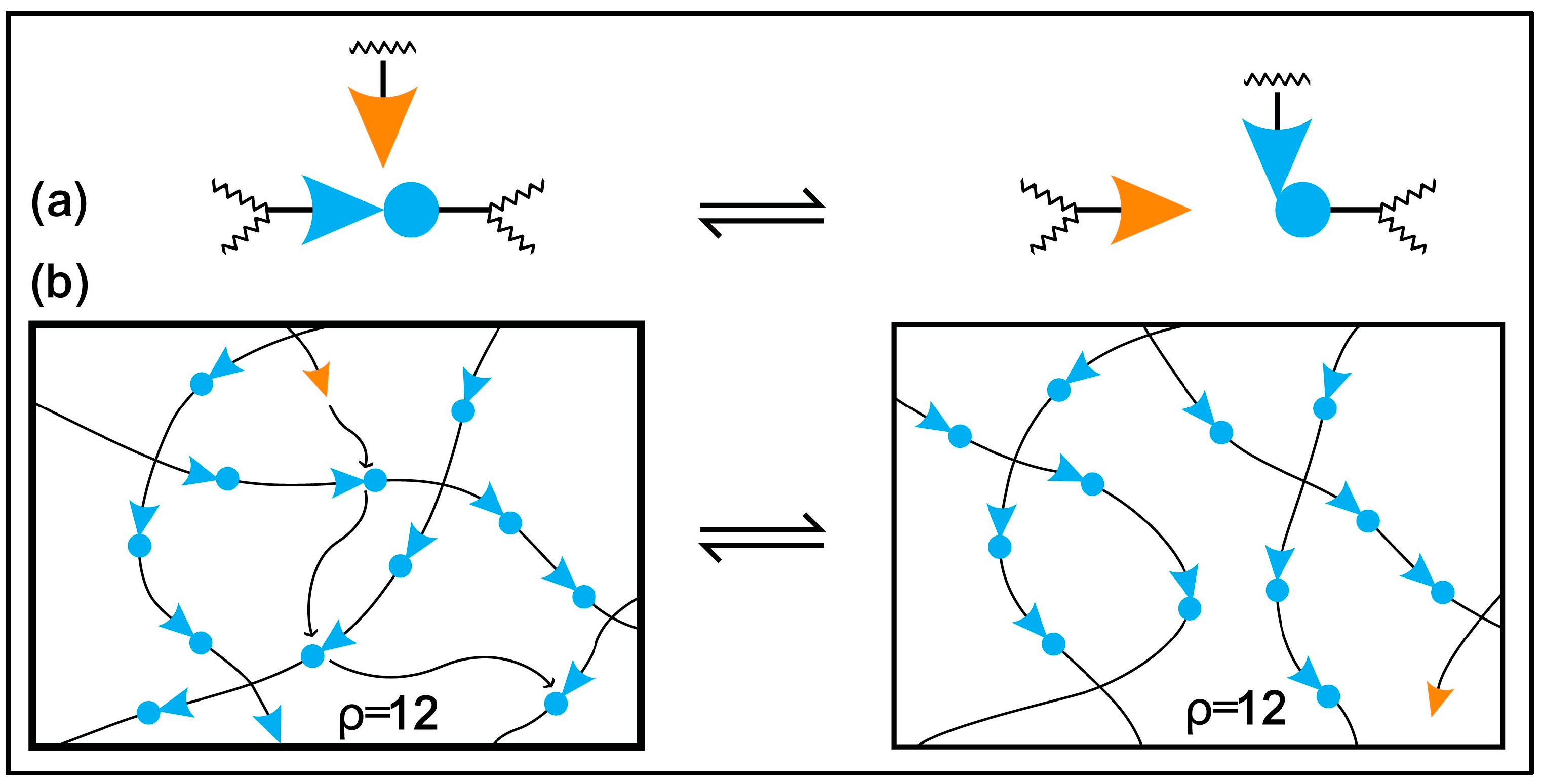
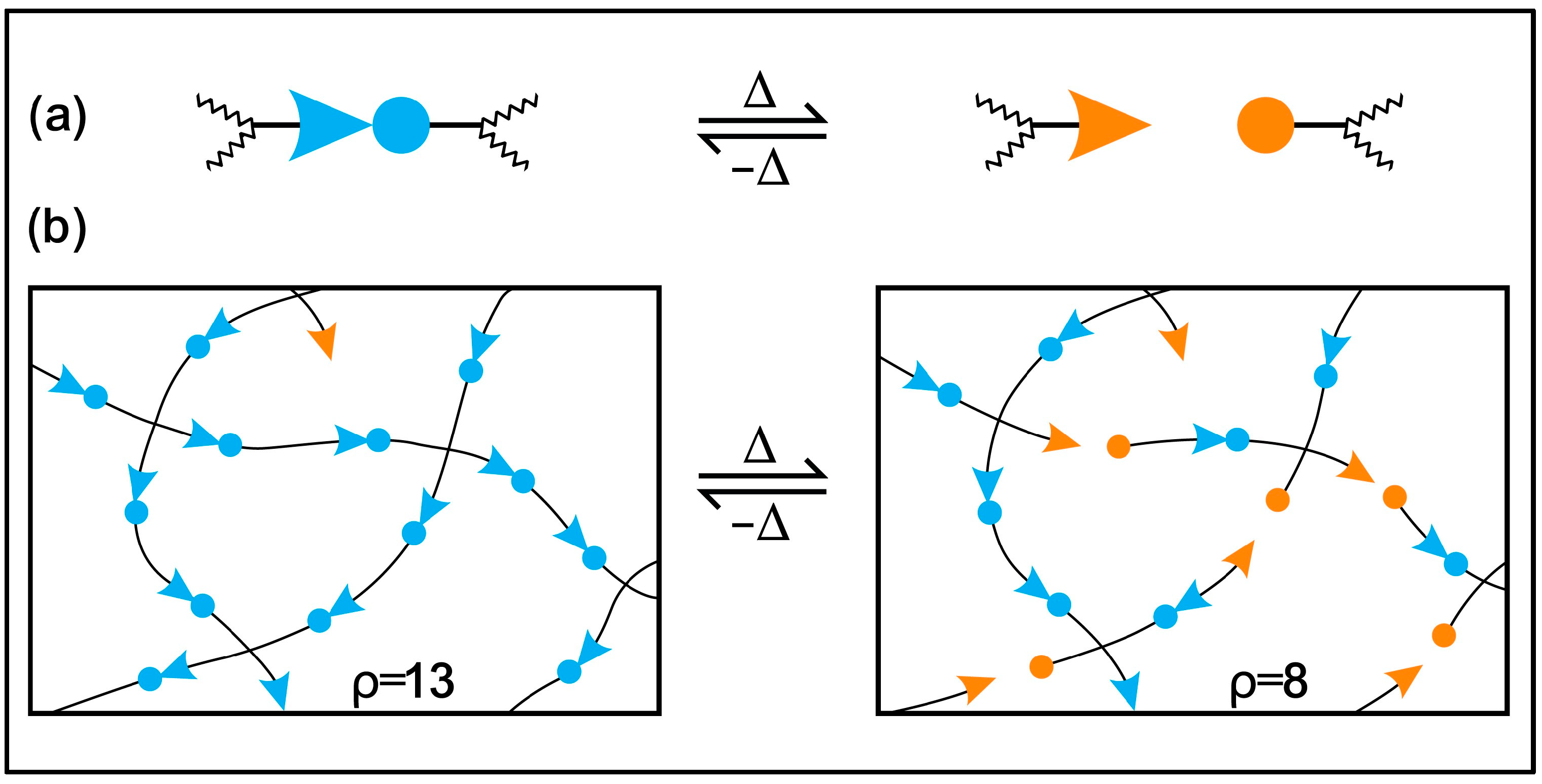
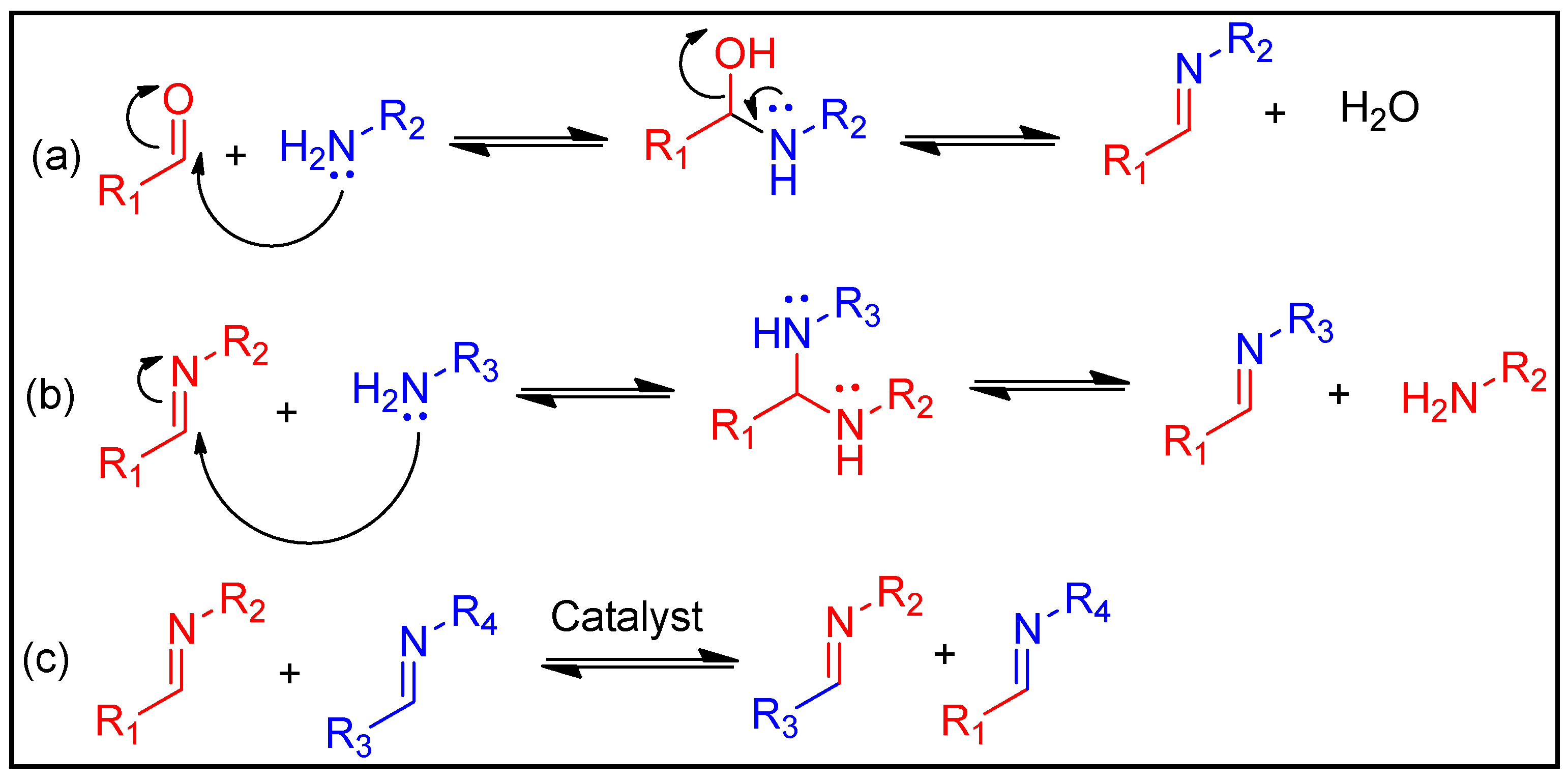
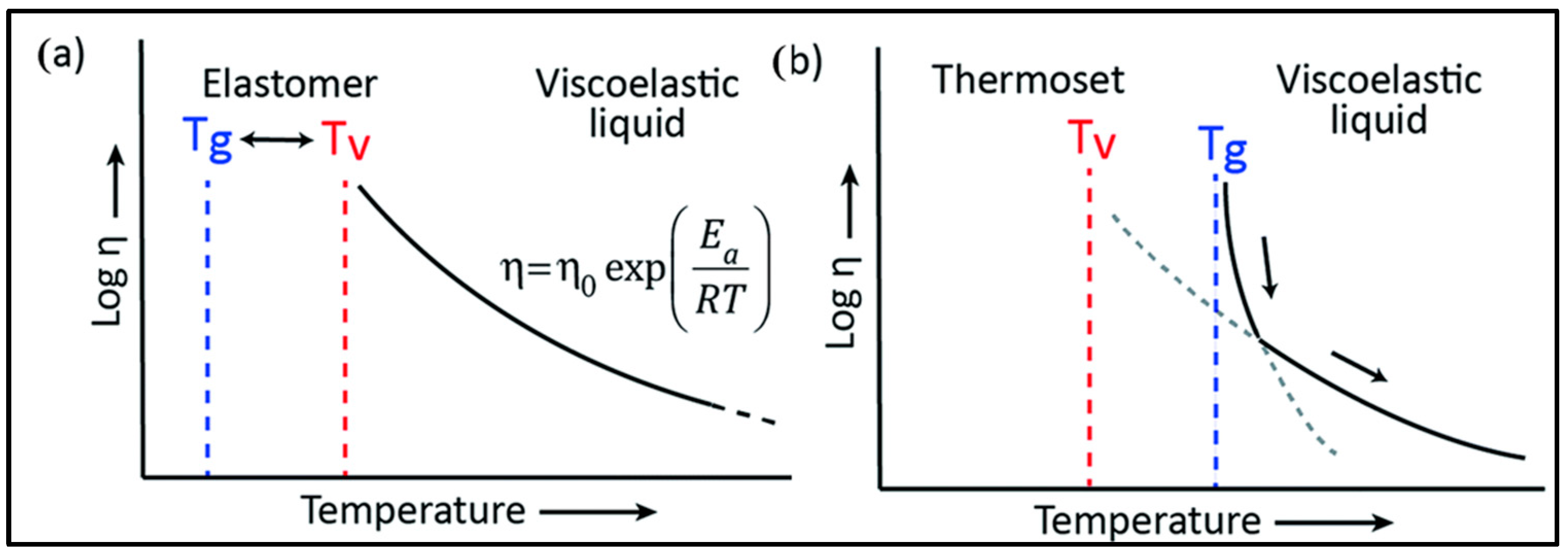





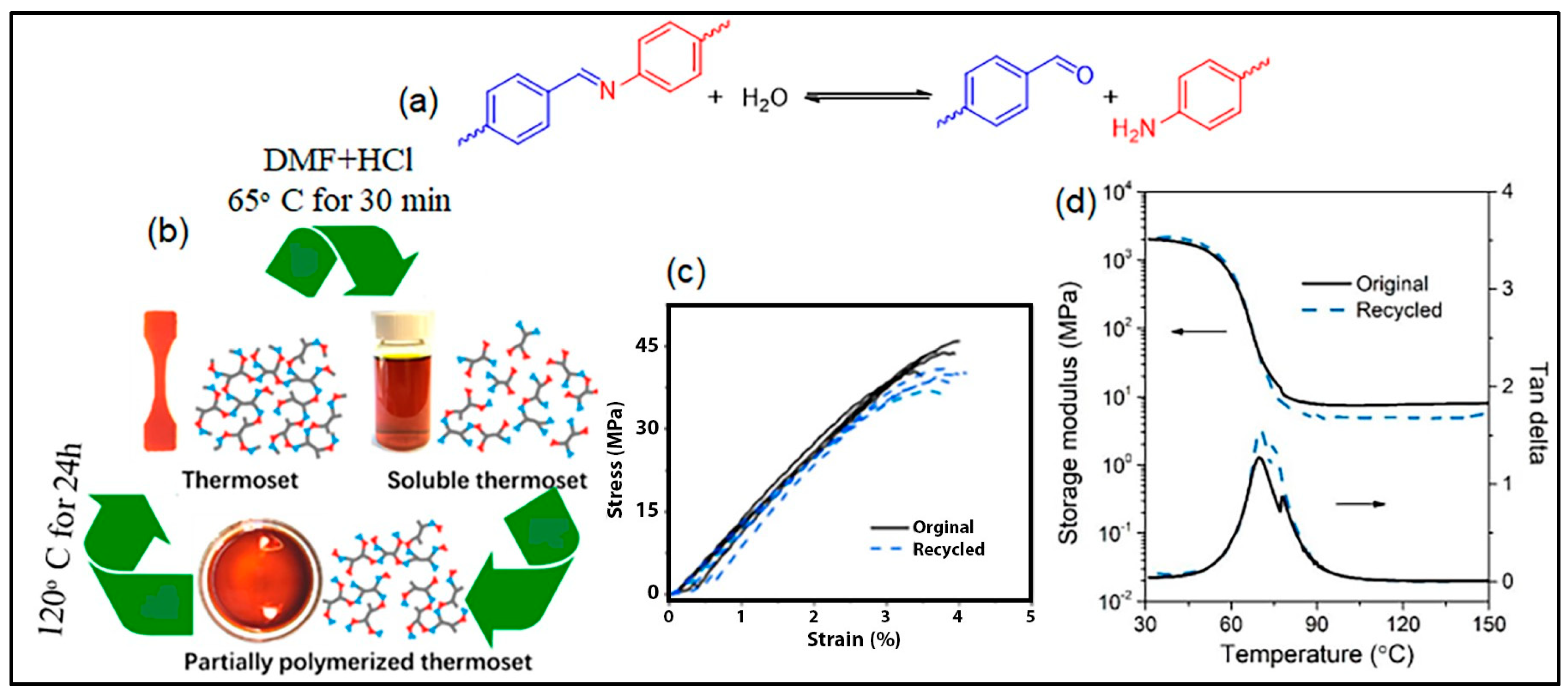
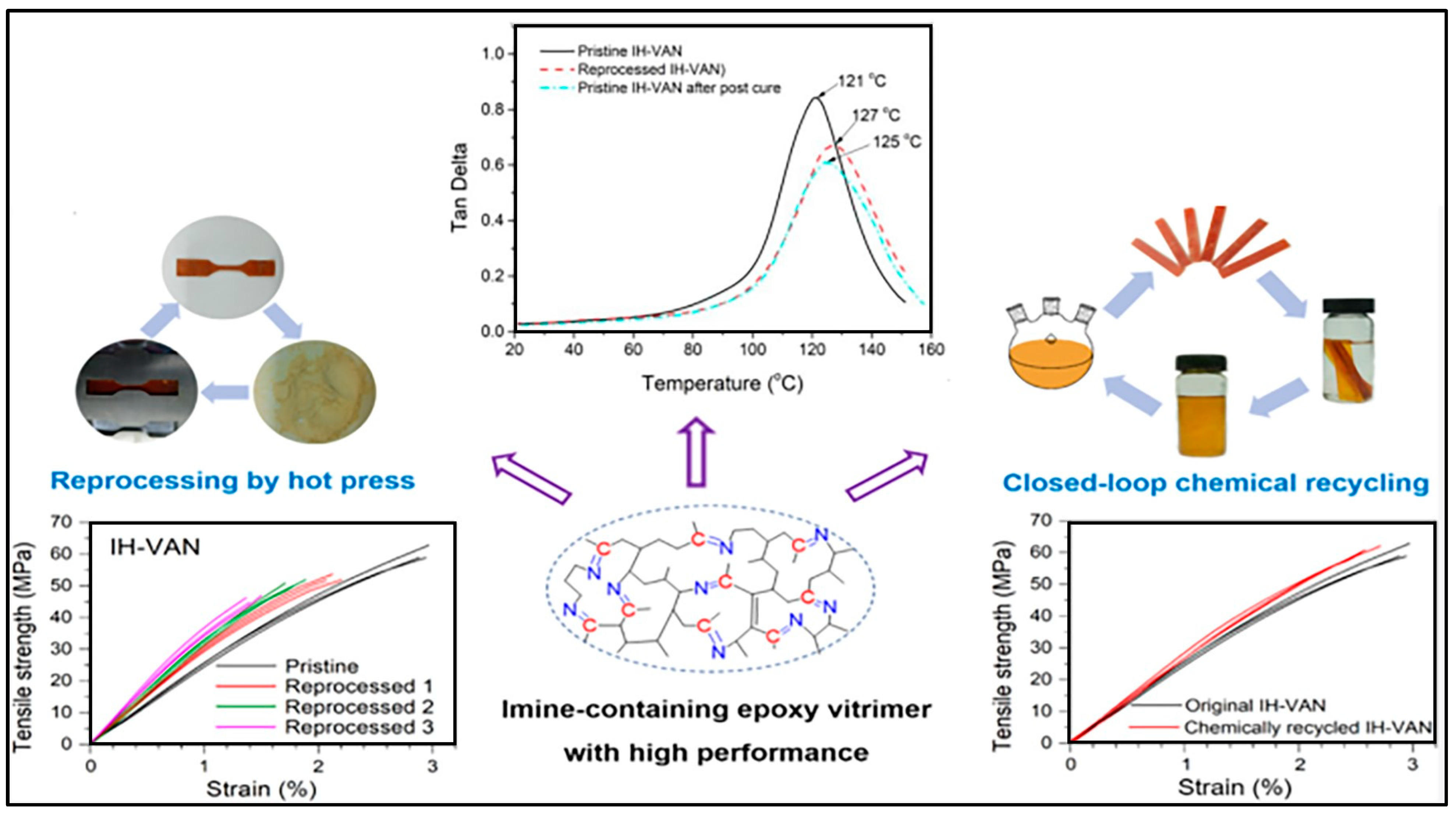


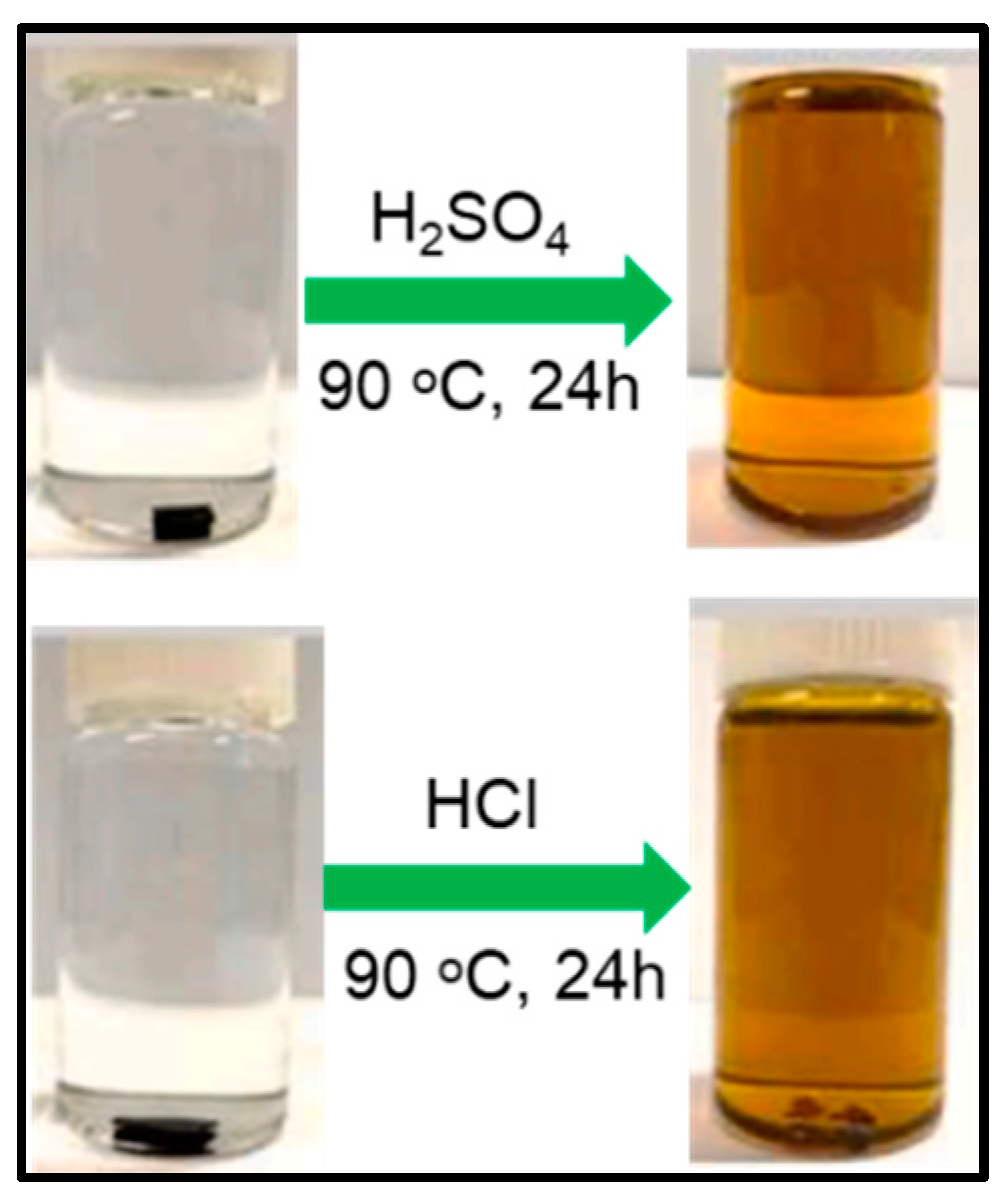
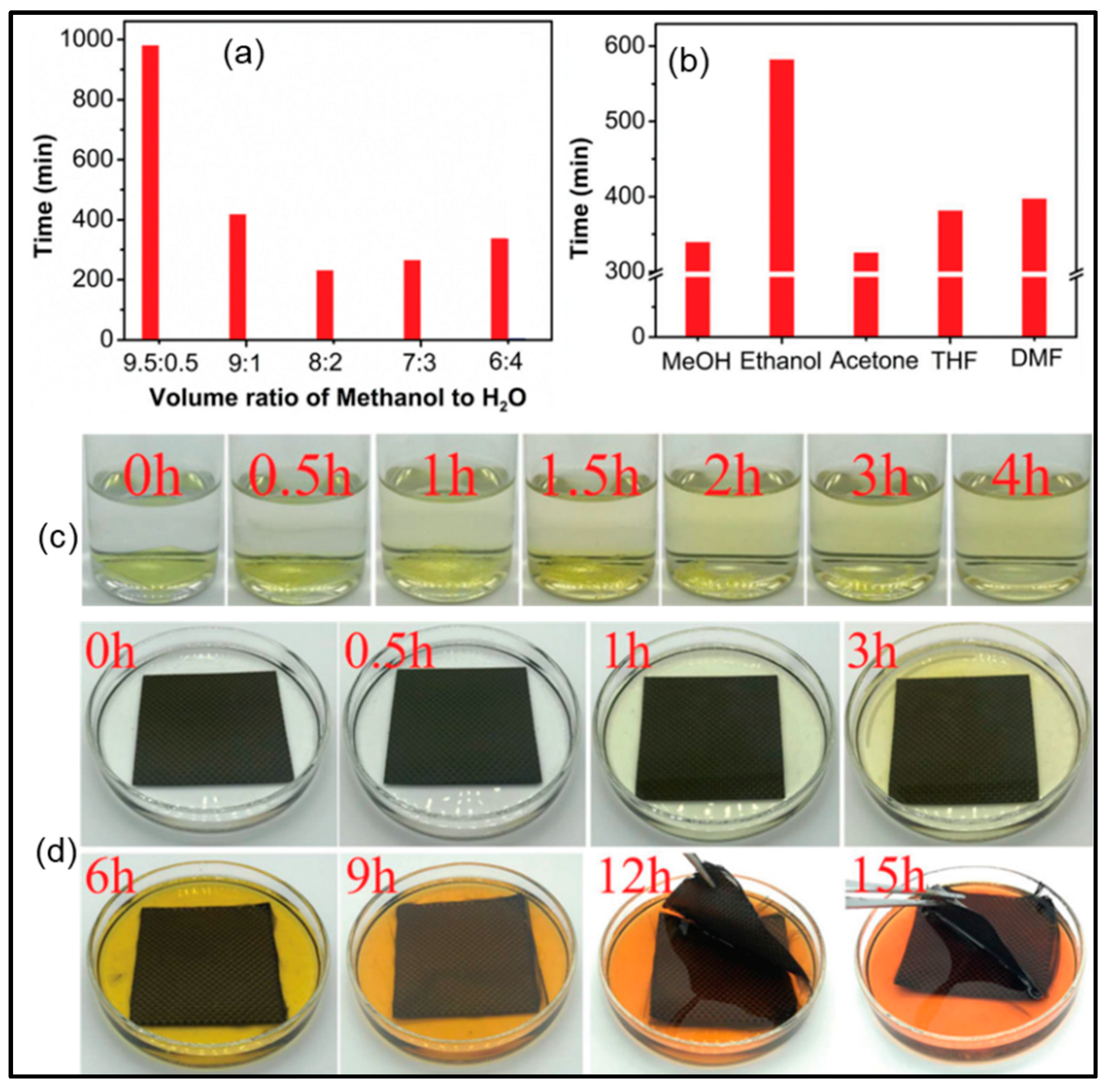
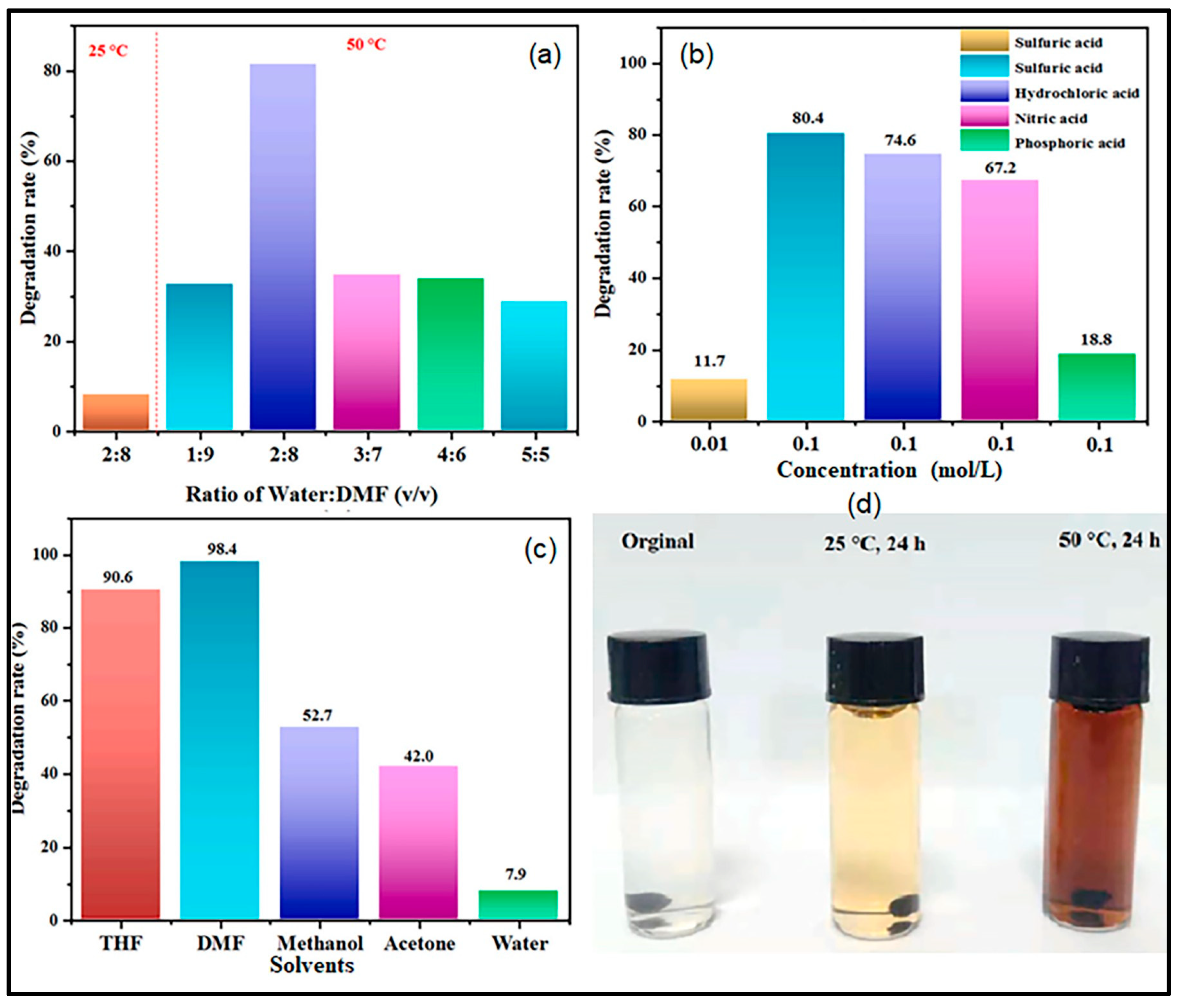
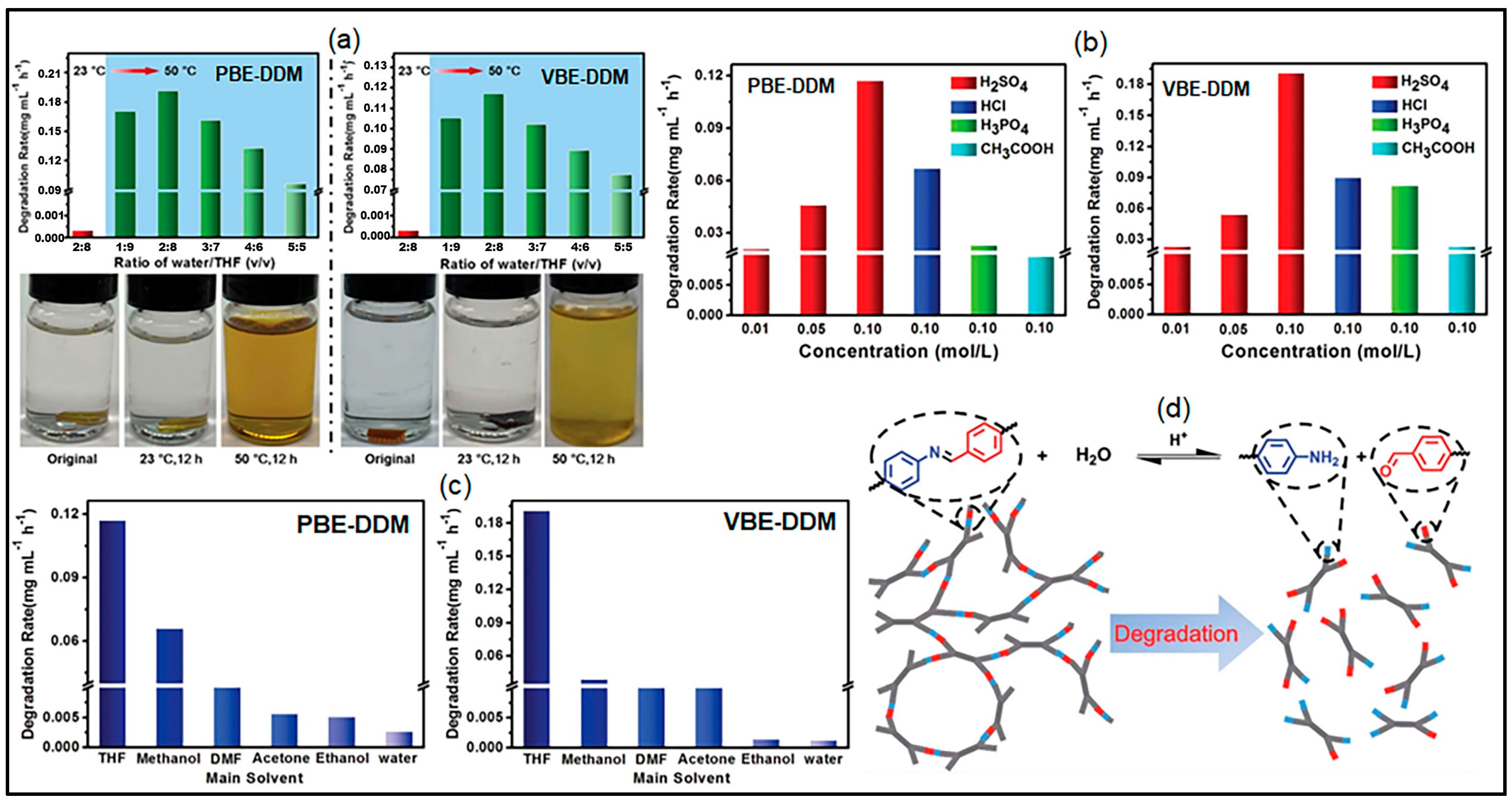
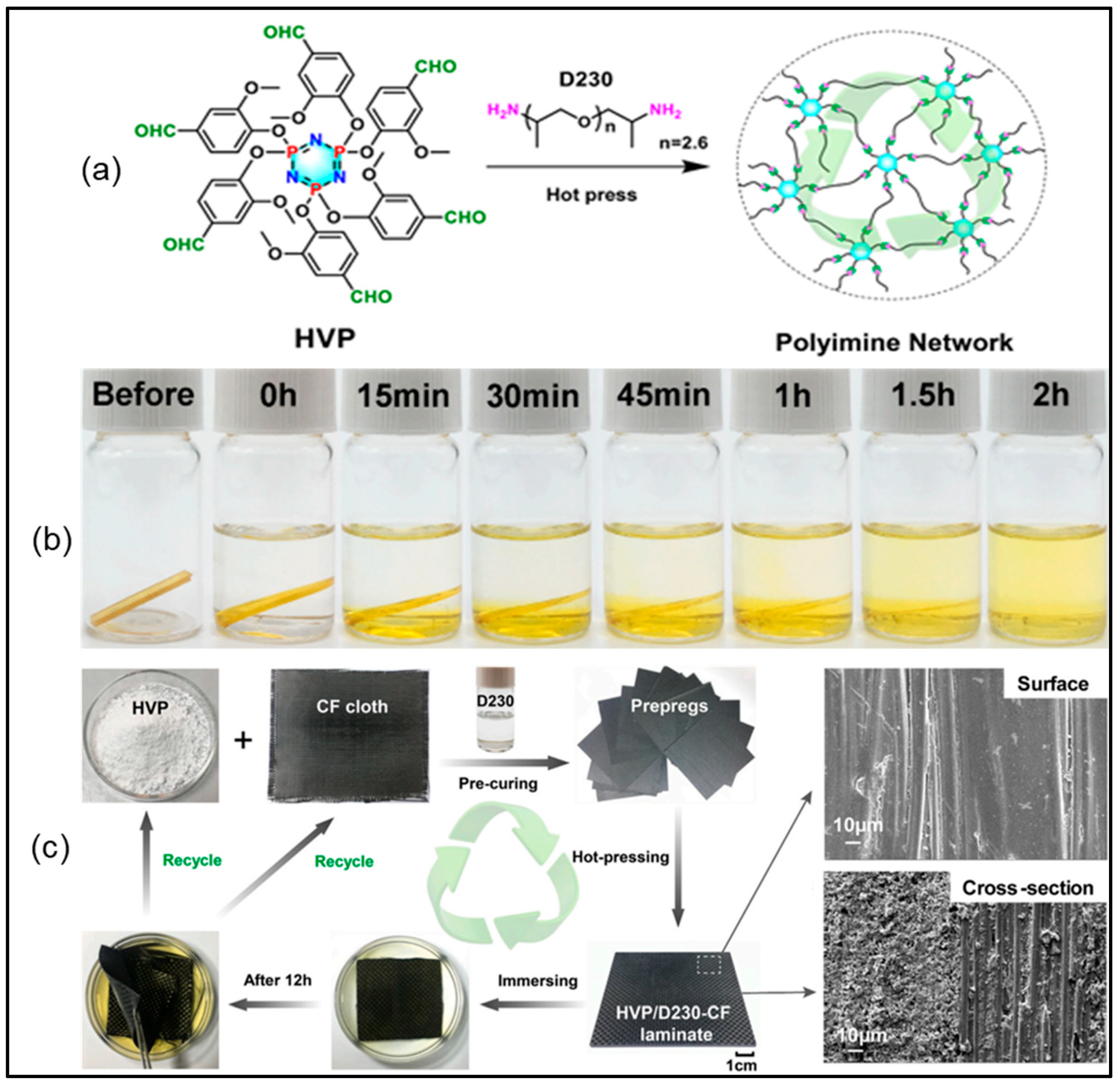
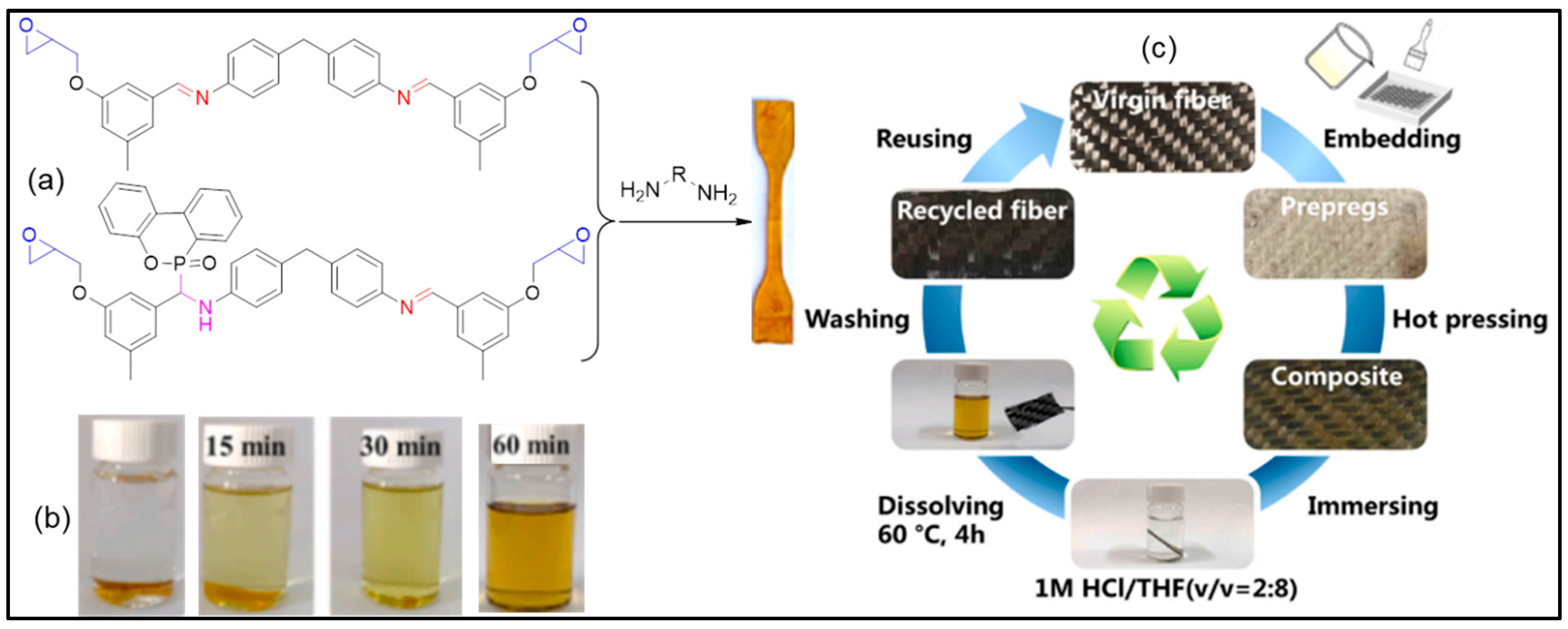
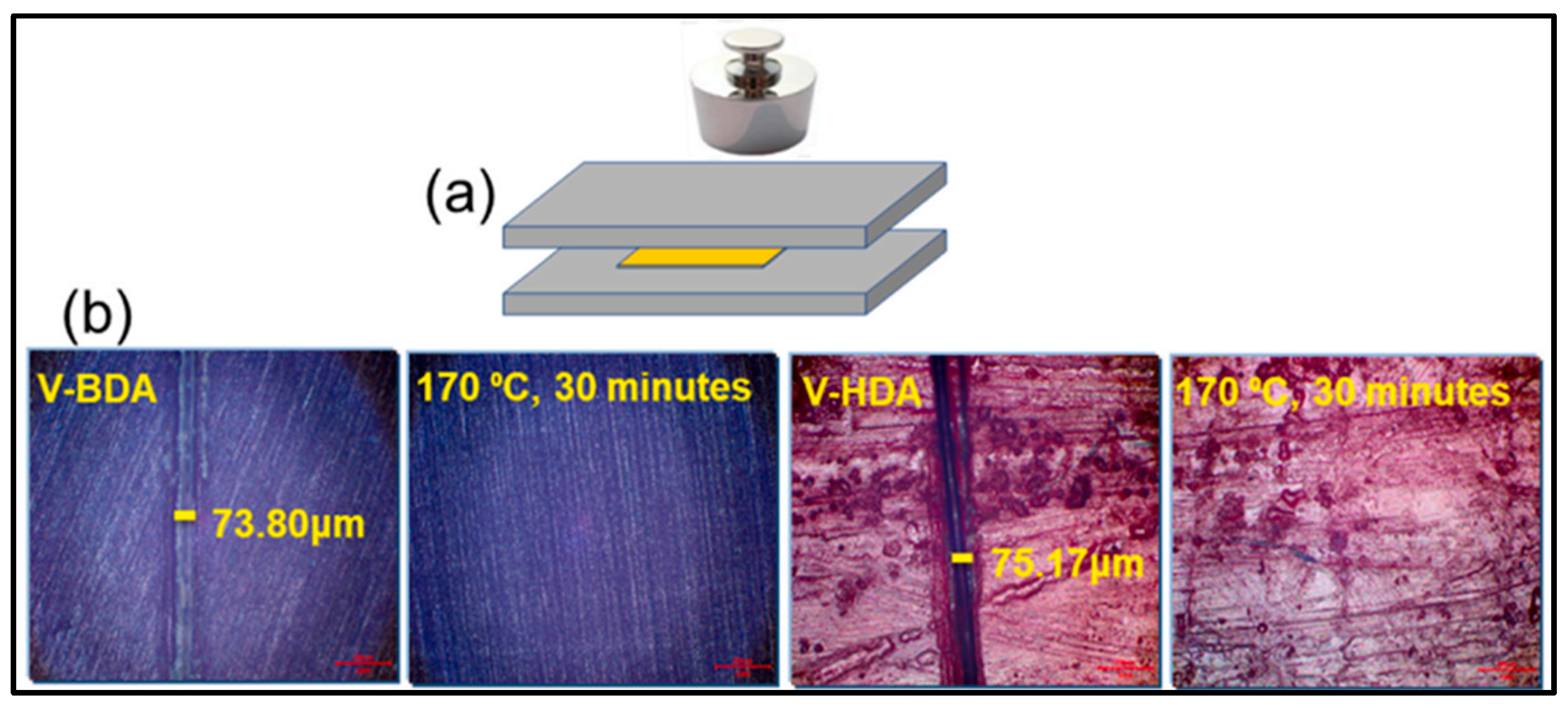
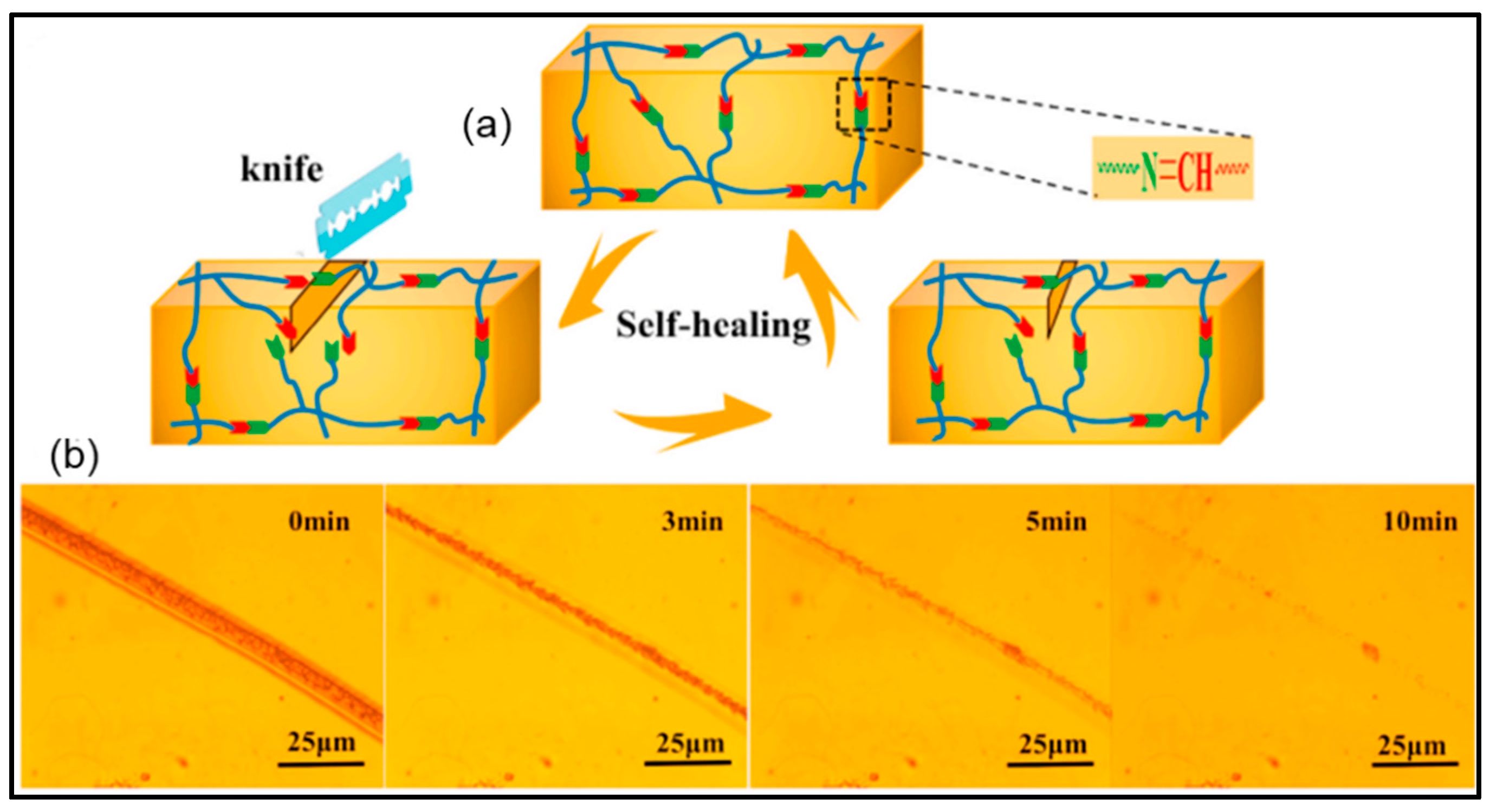
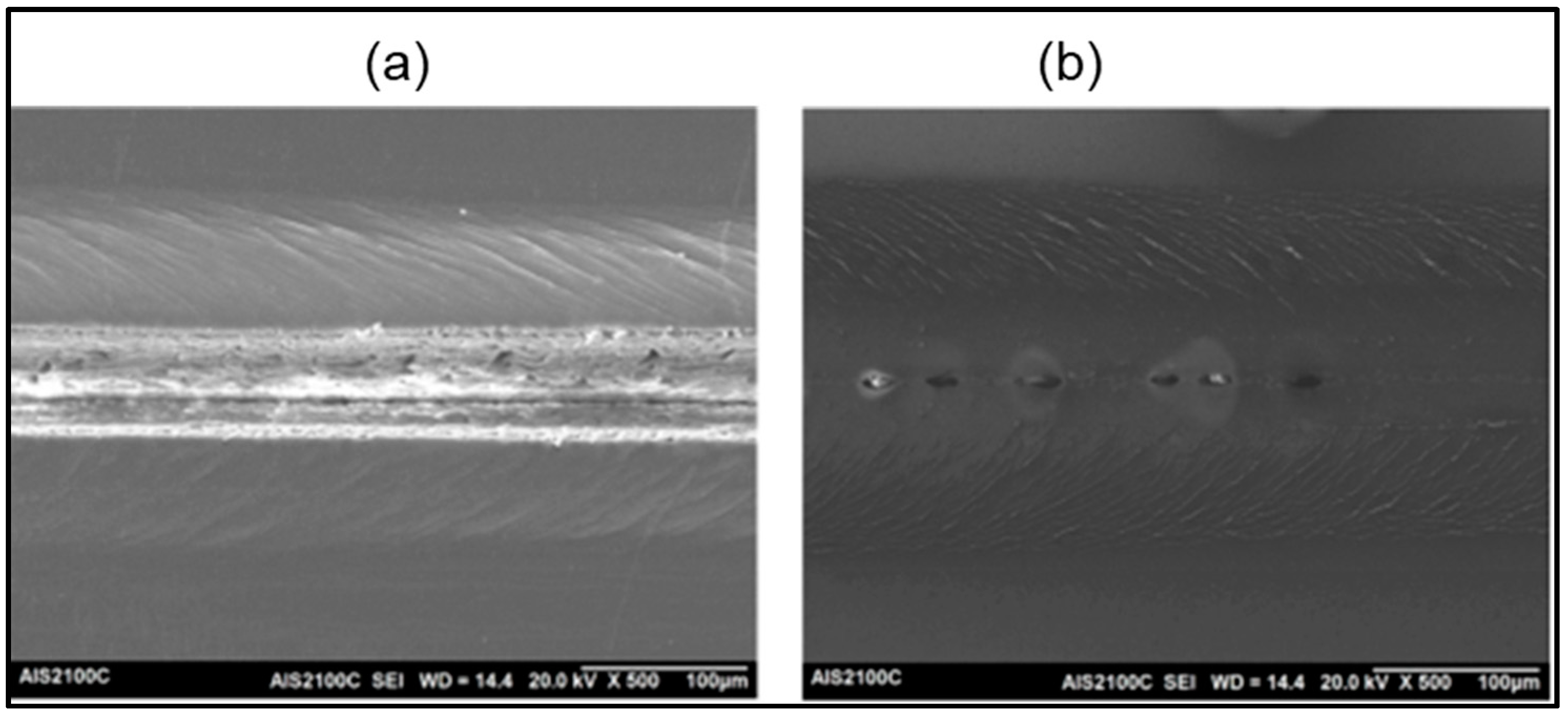
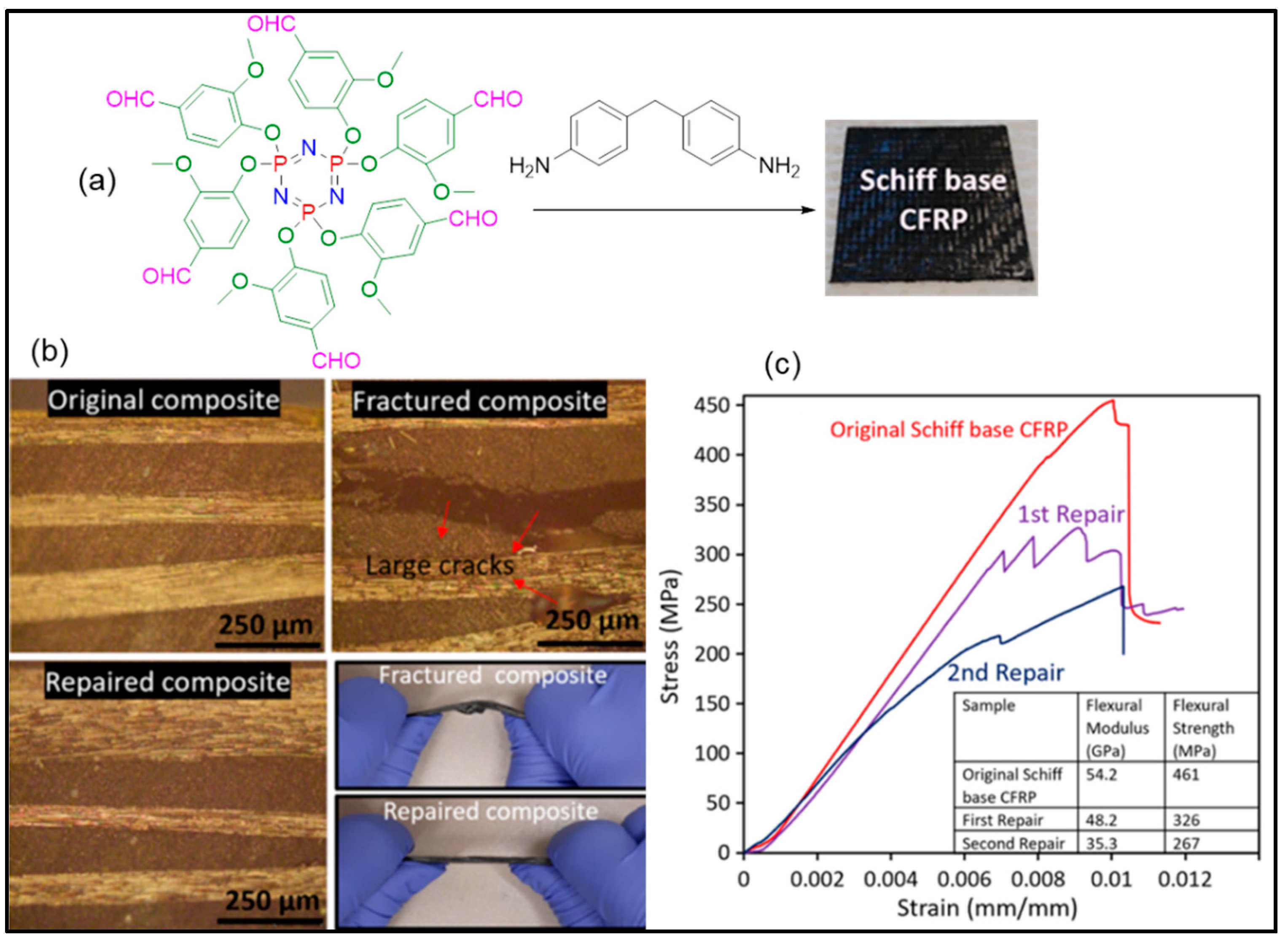



Disclaimer/Publisher’s Note: The statements, opinions and data contained in all publications are solely those of the individual author(s) and contributor(s) and not of MDPI and/or the editor(s). MDPI and/or the editor(s) disclaim responsibility for any injury to people or property resulting from any ideas, methods, instructions or products referred to in the content. |
© 2023 by the authors. Licensee MDPI, Basel, Switzerland. This article is an open access article distributed under the terms and conditions of the Creative Commons Attribution (CC BY) license (https://creativecommons.org/licenses/by/4.0/).
Share and Cite
Emon, J.H.; Rashid, M.A.; Islam, M.A.; Hasan, M.N.; Patoary, M.K. Review on the Synthesis, Recyclability, Degradability, Self-Healability and Potential Applications of Reversible Imine Bond Containing Biobased Epoxy Thermosets. Reactions 2023, 4, 737-765. https://doi.org/10.3390/reactions4040043
Emon JH, Rashid MA, Islam MA, Hasan MN, Patoary MK. Review on the Synthesis, Recyclability, Degradability, Self-Healability and Potential Applications of Reversible Imine Bond Containing Biobased Epoxy Thermosets. Reactions. 2023; 4(4):737-765. https://doi.org/10.3390/reactions4040043
Chicago/Turabian StyleEmon, Jabed Hossen, Muhammad Abdur Rashid, Md. Ariful Islam, Md. Nabiul Hasan, and Mohammed Kayes Patoary. 2023. "Review on the Synthesis, Recyclability, Degradability, Self-Healability and Potential Applications of Reversible Imine Bond Containing Biobased Epoxy Thermosets" Reactions 4, no. 4: 737-765. https://doi.org/10.3390/reactions4040043
APA StyleEmon, J. H., Rashid, M. A., Islam, M. A., Hasan, M. N., & Patoary, M. K. (2023). Review on the Synthesis, Recyclability, Degradability, Self-Healability and Potential Applications of Reversible Imine Bond Containing Biobased Epoxy Thermosets. Reactions, 4(4), 737-765. https://doi.org/10.3390/reactions4040043









